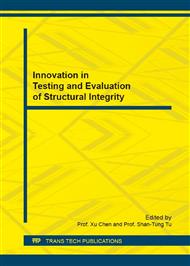p.436
p.441
p.449
p.453
p.458
p.463
p.468
p.473
p.478
Maximum Likelihood Estimation Modeling of Welded Joints Based on Metal Magnetic Memory Parameters
Abstract:
In order to quantitatively identify critical hidden damage for weld joints by using the metal magnetic memory technology (MMM), the modified maximum likelihood estimation MMM model is first proposed. The experimental materials are Q235B welded plate specimens. Fatigue tension experiments were operated to find the MMM feature laws of critical hidden damage by comparing with synchronous X-ray detection results. Four MMM characteristic parameters, that is, ΔHp(y) , Kymax , mmax and S(K), are extracted corresponding to the normal state and the hidden damage state, respectively. The probability density values of ΔHp(y) , Kymax , mmax and S(K)are calculated by the optimized bandwidth kernel density estimation. The quantitative maximum likelihood estimation MMM model is established based on optimized bandwidth kernel density. The verification result shows the maximum likelihood value of hidden damage state is twice as much as that of the normal state, which is consistent with the practical results. This provides a new method for quantitative MMM identification of weld critical hidden damages.
Info:
Periodical:
Pages:
458-462
Citation:
Online since:
September 2016
Authors:
Price:
Сopyright:
© 2017 Trans Tech Publications Ltd. All Rights Reserved
Share:
Citation:


